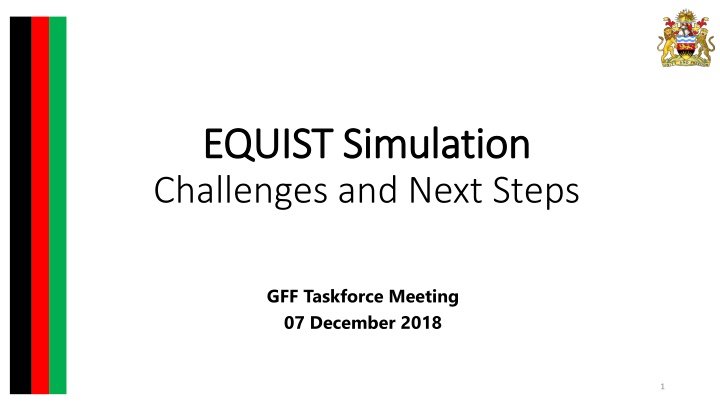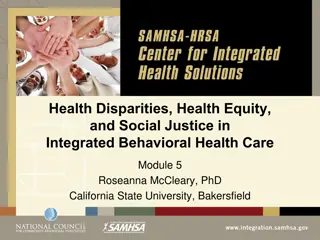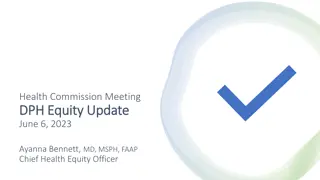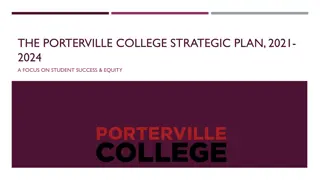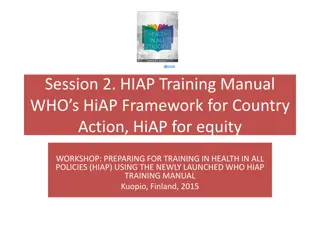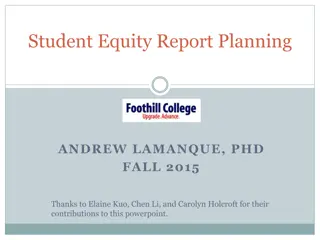EQUIST Simulation Challenges and Next Steps - Strategic Planning for Health Equity
The EQUity Impact Sensitive Tool (EQUIST) is a strategic planning tool aimed at enhancing child and maternal health, and nutrition equity in developing and middle-income countries. This tool assists in identifying priority populations, disease areas causing inequities, and determining the right balance of interventions for improved service delivery. Learn about the overlaps with other analyses, challenges faced in prioritization, and alternative strategies for mitigating key bottlenecks to enhance coverage rates.
Download Presentation

Please find below an Image/Link to download the presentation.
The content on the website is provided AS IS for your information and personal use only. It may not be sold, licensed, or shared on other websites without obtaining consent from the author.If you encounter any issues during the download, it is possible that the publisher has removed the file from their server.
You are allowed to download the files provided on this website for personal or commercial use, subject to the condition that they are used lawfully. All files are the property of their respective owners.
The content on the website is provided AS IS for your information and personal use only. It may not be sold, licensed, or shared on other websites without obtaining consent from the author.
E N D
Presentation Transcript
EQUIST Simulation EQUIST Simulation Challenges and Next Steps GFF Taskforce Meeting 07 December 2018 1
Introduction What is the EQUity Impact Sensitive Tool (EQUIST) A medium-term analysis and strategic planning tool to improve child and maternal health, and nutrition equity in developing and middle-income countries, in a cost- effective manner. Why EQUIST? EQUIST is the recommended tool to conduct situation analysis for the development of the RMNCAH+N Investment Case (IC) for GFF. Background An EQUIST simulation group was set up before the launch of the GFF to work on the simulation prior to the development of the IC to propose a prioritization framework based on the potential lives saved under different scenarios. 2
The EQUIST tool provides a stepwise framework prioritization prioritization stepwise framework for Identify Priority populations based on patterns of mortality rates (by geographic location, residence, wealth status) Identify disease areas which explain inequitable death and malnutrition rates Determine the right balance of interventions by service delivery packages: Community practices, Preventive services, Curative services Identify bottlenecks or challenges that disrupt service delivery for the most deprived. Then identify root causes. Identify effective strategies to mitigate the causes of key bottlenecks to improve coverage rates Compare the impact and cost-effectiveness of intervention scenarios 3
Overlaps with Other Analyses 1. EHP Tool Priority RMNCAH+N interventions identified 2. Service Delivery Analysis Key Gaps and Solutions to be identified for each EHP intervention 3. Financial Gap Analysis Gaps in Health Systems Building Blocks to be identified EQUIST Simulation has to align with the inputs and results of these processes 4
EQUIST Analysis: Challenges and Alternatives Identify Priority populations based on patterns of mortality rates (by geographic location, residence, wealth status, and ethnicity Identify disease areas which explain inequitable death and malnutrition rates The EQUIST tool allows for prioritization based on only one of three parameters wealth, residence (urban/rural), district Once a sub-population is prioritized, there is no further flexibility is tailoring specific interventions to specific regions CHALLENGE Determine the right balance of interventions by service delivery packages: Community practices, Preventive services, Clinical care Identify bottlenecks or challenges that disrupt service delivery for the most deprived. Then identify root causes. The bottleneck analysis (clarified further in slide 5) can be used to identify district-specific bottlenecks Financial Gap analysis can help identify gaps in various health systems building-blocks specific to districts ALTERNATIVE Identify effective strategies to mitigate the causes of key bottlenecks to improve coverage rates Compare the impact and cost-effectiveness of intervention scenarios 5
EQUIST Analysis: Challenges and Alternatives Identify Priority populations based on patterns of mortality rates (by geographic location, residence, wealth status, and ethnicity Identify disease areas which explain inequitable death and malnutrition rates Determine the right balance of interventions by service delivery packages: Community practices, Preventive services, Clinical care CHALLENGE Identify bottlenecks or challenges that disrupt service delivery for the most deprived. Then identify root causes. Family planning, ITN, Caesarean section Size of burden based on mortality rather than DALYs The EQUIST tool does not cover all the interventions included in the EHP. Eg. Identify effective strategies to mitigate the causes of key bottlenecks to improve coverage rates ALTERNATIVE The EHP Tool prioritizes interventions based on the size of achievable Compare the impact and cost-effectiveness of intervention scenarios population health impact (DALYs averted) given the cost-effectiveness of interventions, disease burden, and realistic coverage rates. 6
EQUIST Analysis: Challenges and Alternatives CHALLENGE Under the bottleneck analysis, indicators provided for determinants of coverage are often not useful. Eg. "Women WITH exposure to any mass media for geographic accessibility, "whether a vaccination card was shown (during Identify Priority populations based on patterns of mortality rates (by geographic location, residence, wealth status, and ethnicity survey)" for access to commodities ALTERNATIVE Identify disease areas which explain inequitable death and malnutrition rates In order to carry out a proper bottleneck analysis relevant to the Malawian context, the following steps are needed: i) identify underperforming EHP interventions, ii) identify appropriate indicators for bottleneck analysis. This will follow from the work done by the Service Delivery Group. Determine the right balance of interventions by service delivery packages: Community practices, Preventive services, Clinical care Identify bottlenecks or challenges that disrupt service delivery for the most deprived. Then identify root causes. Identify effective strategies to mitigate the causes of key bottlenecks to improve coverage rates Compare the impact and cost-effectiveness of intervention scenarios 7
EQUIST Analysis: Challenges and Alternatives Identify Priority populations based on patterns of mortality rates (by geographic location, residence, wealth status, and ethnicity Financing, Service Delivery, Medical products, Health workforce, Governance and Leadership, Information. The calculation of effect size for strategies and their effect on coverage rates is a black box. The EQUIST tool provides a list of potential strategies under the following areas CHALLENGE Identify disease areas which explain inequitable death and malnutrition rates ALTERNATIVE The identification of strategies will follow from the work done by the Service Determine the right balance of interventions by service delivery packages: Community practices, Preventive services, Clinical care Delivery Group on identifying key gaps and relevant strategies. Based on the indicators identified in the bottleneck step, the effect on target coverage rates can be calculated. Identify bottlenecks or challenges that disrupt service delivery for the most deprived. Then identify root causes. Identify effective strategies to mitigate the causes of key bottlenecks to improve coverage rates Compare the impact and cost-effectiveness of intervention scenarios 8
EQUIST Analysis: Challenges and Alternatives Identify Priority populations based on patterns of mortality rates (by geographic location, residence, wealth status, and ethnicity superior to the costing methodology applied in the EQUIST simulation. Impact: Impact is calculated only in terms of number of lives saved, not DALYs. Cost: It has been observed that the One-Health Tool costing methodology is CHALLENGE Identify disease areas which explain inequitable death and malnutrition rates Cost: Malawi already has a comprehensive costing of various strategies Determine the right balance of interventions by service delivery packages: Community practices, Preventive services, Clinical care (HSSP-II, HRH, MEHIS, Capital Investment). Costs of prioritized strategies can be extrapolated from here. Impact: Additional DALYs averted can be calculated based on estimated target coverage rates using the EHP tool. ALTERNATIVE Identify bottlenecks or challenges that disrupt service delivery for the most deprived. Then identify root causes. Identify effective strategies to mitigate the causes of key bottlenecks to improve coverage rates Compare the impact and cost-effectiveness of intervention scenarios 9
Calculation of Impact using the EHP Tool Full EHP RMNCAH + Nutrition Impact if coverage rates are increased to 100% 52.5 million 24.5 million Full Implementation DALYs Averted (per year) Realistic Implementation* 26.2 million 12.1 million * based on realistic coverage rates in 2014 10
Next Steps and Timeline Activity Drafting Groups Deadline Test the usefulness of the EQUIST tool in the Malawian context and validate results with the GFF Taskforce Impact simulation group December 7, 2018 Agree on an analysis framework All Writing Groups December 14, 2018 Impact simulation, Service delivery, Cross-cutting groups Finalize Bottleneck Analysis January 18, 2018 Impact simulation, Service delivery groups Finalize Strategies January 31, 2018 Impact simulation, Service delivery, Health systems strengthening, Financial gap analysis groups Finalize Cost and Impact Analysis February 15, 2018 11
